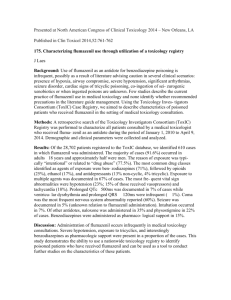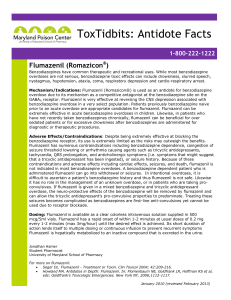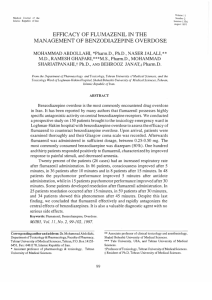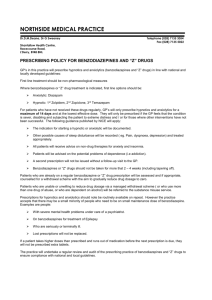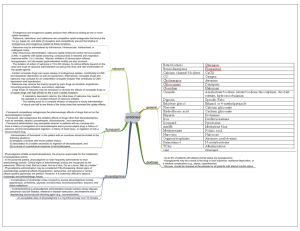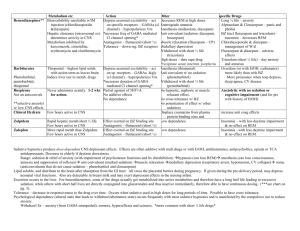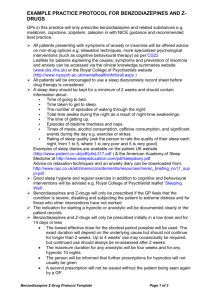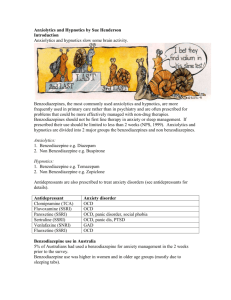FINAL CORE SAFETY PROFILE Flumazenil DATE of approval: 6
advertisement
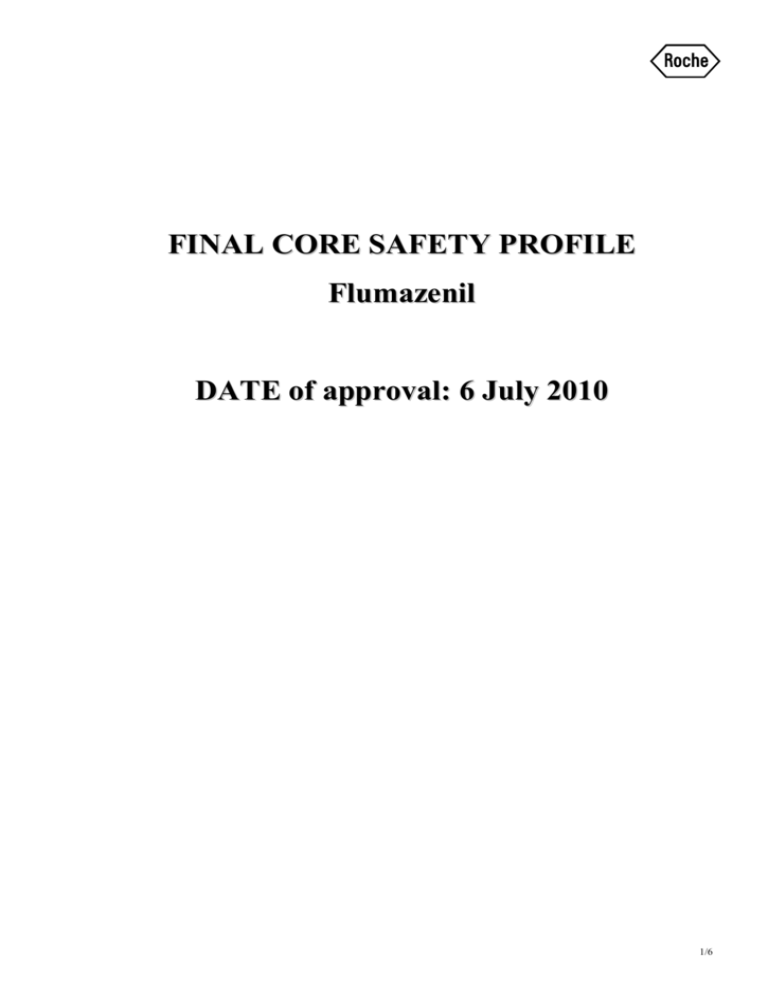
FINAL CORE SAFETY PROFILE Flumazenil DATE of approval: 6 July 2010 1/6 ANNEX TO PSUR CORE SAFETY PROFILE for flumazenil; intravenous injection (Sections 4.2 (safety information only); 4.3-4.9) 4.2 Posology and method of administration (for the CSP only the safety information is applicable) Flumazenil must be administered intravenously by an anesthetist or a doctor with experience in anesthesiology. Flumazenil may be administered either undiluted or diluted. For dilution, see section 6.6. It can be administered together with other reanimation measures. Anesthesiology: The initial dose is 0.2 mg administered i.v. in 15 seconds. If the desired degree of consciousness is not obtained within 60 seconds, a second dose of 0.1 mg can be administered. This may be repeated at 60-second intervals where necessary, up to a total dose of 1 mg. The usual dose is 0.3-0.6 mg. Intensive care: The recommended initial dose of Flumazenil is 0.3 mg i.v. If the desired level of consciousness is not obtained within 60 seconds, a repeat dose of 0.1 mg may be administered. If necessary, this may be repeated at 60-second intervals up to a total dose of 2 mg. If drowsiness recurs, a second bolus injection of Flumazenil may be administered. An i.v. infusion of 0.1-0.4 mg per hour has also been shown to be useful. The dosage and the rate of infusion should be individually adjusted to the desired level of sedation. Children above 1 year of age: For the reversal of conscious sedation induced with benzodiazepines in children > 1 year of age, the recommended initial dose is 0.01 mg/kg (up to 0.2 mg) administered i.v. over 15 seconds. If the desired level of consciousness is not obtained after waiting an additional 45 seconds, further injection of 0.01 mg/kg may be administered (up to 0.2 mg) and repeated at 60-second intervals where necessary (a maximum of 4 times) to a maximum total dose of 0.05 mg/kg or 1 mg, whichever is lower. The dose should be individualised 2/6 based on the patient’s response. No data are available on the safety and efficacy of repeated administration of Flumazenil to children for re-sedation. 4.3 Contraindications Flumazenil is contraindicated in patients: with hypersensitivity to the active substance or any of the excipients who have been administered benzodiazepines for the treatment of a potentially lifethreatening condition (e.g. increased intracranial pressure or status epilepticus). 4.4 Special warnings and precautions for use - Until sufficient data are available, Flumazenil should only be administered to children below the age of 1 year if the risks to the patient (especially in the case of accidental overdose) have been weighed up against the benefits of the treatment. - Elimination may be delayed in patients with hepatic impairment. - The antagonistic effect of Flumazenil is specific to benzodiazepines; an effect is therefore not to be expected if the 'non-awakening' is caused by other substances. If Flumazenil is administered for anesthesiology at the end of the operation, the effect of the peripheral muscle relaxants must first have disappeared. Because Flumazenil generally has a shorter duration of action than the benzodiazepines and therefore sedation can re-occur, the clinical state of the patient must be monitored, preferably in the intensive care unit, until the effect of Flumazenil is eliminated. - In high-risk patients, the benefits of a benzodiazepine-induced sedation should be weighed up against the risks of a rapid return to consciousness. In patients (e.g. with cardiac problems), maintenance of a certain degree of sedation during the early postoperative period may be preferable to complete consciousness. - Rapid injection of Flumazenil should be avoided. In patients with high dose and/or longterm exposure to benzodiazepines ending at any time within the weeks preceding Flumazenil administration, rapid injection of doses equal to or higher than 1 mg has led to withdrawal symptoms, including palpitations, agitation, anxiety, emotional lability as well as mild confusion and sensory distortions. - In patients who are anxious during the pre operative phase or in patients who are known to suffer from chronic or transient anxiety, the dosage of Flumazenil should be adjusted carefully. - However, after major surgery, the post operative pain should be considered and it may be preferable to keep the patient lightly sedated. - For patients who have been treated chronically with high doses of benzodiazepines, the advantages of the use of Flumazenil should be carefully weighed up against the risk of withdrawal symptoms; if, despite careful dosing, withdrawal symptoms occur, treatment with low doses of benzodiazepines, titrated intravenously according to the patient’s response, may be considered if necessary. 3/6 - Use of the antagonist is not recommended in patients with epilepsy who have been treated with benzodiazepines for a prolonged period. Although Flumazenil exerts a slight intrinsic anticonvulsant effect, the abrupt suppression of the protective effect of a benzodiazepine agonist can induce convulsions in epileptic patients. - In patients with severe brain injury (and/or instable intracranial pressure) who are being treated with Flumazenil – to antagonise the effects of benzodiazepines – increased intracranial pressure may develop. - Particular caution is necessary when using Flumazenil in cases of mixed-drug overdose. In particular in the case of an intoxication with benzodiazepines and cyclic antidepressants, certain toxic effects such as convulsions and cardiac arrhythmias, which are caused by these antidepressants but which emerge less readily on concomitant administration with benzodiazepines, are exacerbated on administration of Flumazenil. - Patients who have received Flumazenil for the reversal of benzodiazepine effects should be monitored for resedation, respiratory depression or other residual benzodiazepine effects for an appropriate period based on the dose and duration of effect of the benzodiazepine employed. - Flumazenil is not recommended for the treatment for benzodiazepine dependence or for the treatment of protracted benzodiazepine abstinence syndromes. 4.5 Interaction with other medicinal products and other forms of interaction Flumazenil antagonises the central effects of benzodiazepines by competitive interaction at the receptor. The effects of non-benzodiazepine agonists that act via the benzodiazepine receptor, such as zopiclon, triazolopyridazine and others, are also blocked by Flumazenil. Interactions with other centrally acting substances have not been observed. The pharmacokinetics of benzodiazepines are not influenced by the antagonist Flumazenil. On administering Flumazenil concomitantly with the benzodiazepines midazolam, flunitrazepam and lormetazepam, the pharmacokinetic parameters of Flumazenil were unaffected. There is no pharmacokinetic interaction between ethanol and Flumazenil. 4.6 Pregnancy and lactation There are insufficient data on use in human pregnancy for an assessment of possible harmful effects and efficacy in the foetus. Caution is therefore required. To date, there is no evidence of harmful effects in animal studies. The efficacy in the foetus has not been investigated in animal studies. It is not known whether Flumazenil passes into breast milk. In emergency situations, however, the parenteral administration of Flumazenil to a patient who is breastfeeding is not contraindicated. 4.7 Effects on ability to drive and use machines 4/6 Although patients are awake and conscious after administration of Flumazenil, they should be advised not to operate dangerous machinery or drive a vehicle during the first 24 hours, because the effect of the earlier administered benzodiazepine may recur. 4.8 Undesirable effects The adverse events listed below have been reported. Adverse events usually subside rapidly without the need for special treatment. Frequency categories are defined using the following convention: very common (≥1/10); common (≥1/100 to <1/10); uncommon (≥1/1,000 to <1/100); rare (≥1/10,000 to <1/1,000); very rare (<1/10,000); unknown (cannot be estimated from the available data). Psychiatric disorders Uncommon: anxiety, fear: following rapid injection, generally did not require treatment. Unknown: Withdrawal symptoms (e.g., agitation, anxiety, emotional lability, confusion, sensory distortions), following rapid injection of doses of 1 mg or more in patients with high-dose and/or long-term exposure to benzodiazepines ending at any time within the weeks preceding Flumazenil administration (see section 4.4); panic attacks (in patients with a history of panic reactions); abnormal crying, agitation, aggressive reactions (the side effect profile in children is generally similar to that in adults. When Flumazenil has been used for the reversal of conscious sedation, abnormal crying, agitation and aggressive reactions have been reported). Nervous system disorders Unknown: Seizures: particularly in patients known to suffer from epilepsy or severe hepatic impairment, mainly after long-term treatment with benzodiazepines or in cases of mixeddrug overdose (see section 4.4). Cardiac disorders Uncommon: Palpitations: following rapid injection, generally did not require treatment. Vascular disorders Unknown: Transient increased blood pressure (on awakening). Gastrointestinal disorders Common: Nausea: vomiting: during post-operative use, particularly if opiates have also been used. Skin and subcutaneous tissue disorders Unknown: Flushing. General disorders and administration site conditions Unknown: Chills: following rapid injection, generally did not require treatment. 5/6 4.9 Overdose In cases of mixed-drug overdose, particularly with cyclic antidepressants, toxic effects (such as convulsions and cardiac dysrhythmias) may emerge with the reversal of benzodiazepine effects by Flumazenil. There is very limited experience of acute overdose in humans with Flumazenil. There is no specific antidote for overdose with Flumazenil. Treatment should consist of general supportive measures including monitoring of vital signs and observation of the clinical status of the patient. Even at dosages of 100 mg i.v., no symptoms of overdosage were observed. 6/6
